Nepal Gallery

 Durbar Square is the center of all activities in old Kathmandu. It just seems to draw you towards it. On my first day in the city, I picked a direction, followed the flow of human traffic, and just ended up there. Its got ancient temples and statues, the old Royal Palace, and even a house where the city's living goddess (the Kumari) lives. There are street vendors hawking everything from bananas to trinkets, shops selling thangkas (traditional Tibetan paintings), and several sadhus, or Hindu holy men, who will gladly pose for photographs for an appropriate modeling fee.
Durbar Square is the center of all activities in old Kathmandu. It just seems to draw you towards it. On my first day in the city, I picked a direction, followed the flow of human traffic, and just ended up there. Its got ancient temples and statues, the old Royal Palace, and even a house where the city's living goddess (the Kumari) lives. There are street vendors hawking everything from bananas to trinkets, shops selling thangkas (traditional Tibetan paintings), and several sadhus, or Hindu holy men, who will gladly pose for photographs for an appropriate modeling fee.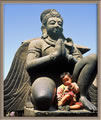 This little girl was sitting in the lap of a statue while her mother crouched below selling fruit from a shawl spread on the ground. The girl's clothes were dirty, and she had a large sore on her leg. But her mother beamed a huge smile at me when she saw that I had taken a platonic interest in her daughter. Without a common language, we communicated with further smiles and simple gestures. But it was a poignant moment for me. I was very aware that I had in my hand a camera worth more than this entire family would make in ten years or more.
This little girl was sitting in the lap of a statue while her mother crouched below selling fruit from a shawl spread on the ground. The girl's clothes were dirty, and she had a large sore on her leg. But her mother beamed a huge smile at me when she saw that I had taken a platonic interest in her daughter. Without a common language, we communicated with further smiles and simple gestures. But it was a poignant moment for me. I was very aware that I had in my hand a camera worth more than this entire family would make in ten years or more. Nepal is officially a Hindu kingdom, but in reality the religion is a mixture of Hindu and Buddhist beliefs. Cows, of course, are sacred and are neither slaughtered nor used as beasts of burden. They have free rein to wander the streets and sleep wherever they want. You know you're in a different world when your taxi is caught in a traffic jam caused by a cow sitting in the middle of the road.
Nepal is officially a Hindu kingdom, but in reality the religion is a mixture of Hindu and Buddhist beliefs. Cows, of course, are sacred and are neither slaughtered nor used as beasts of burden. They have free rein to wander the streets and sleep wherever they want. You know you're in a different world when your taxi is caught in a traffic jam caused by a cow sitting in the middle of the road. This highly ornate and colorful Hindu temple was abuzz with activity late in the evening.
This highly ornate and colorful Hindu temple was abuzz with activity late in the evening. The temple of Swayambhunath sits atop a hill west of Kathmandu. It houses a large colony of monkeys which will happily grab offerings of food. Or cameras, hats, bags, sunglasses. Around the base of the stupa is a series of prayer wheels which believers spin as they pass by. Each prayer wheel carries the sacred om mani padme hom mantra. The small colorful flags also carry mantras, each flutter in the wind carrying the words away.
The temple of Swayambhunath sits atop a hill west of Kathmandu. It houses a large colony of monkeys which will happily grab offerings of food. Or cameras, hats, bags, sunglasses. Around the base of the stupa is a series of prayer wheels which believers spin as they pass by. Each prayer wheel carries the sacred om mani padme hom mantra. The small colorful flags also carry mantras, each flutter in the wind carrying the words away.
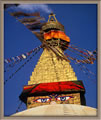 Bodhnath, a few miles outside Kathmandu, is the center of Nepal's sizeable Tibetan Buddhist community. The stupa dates from the 14th century and is said to contain a fragment of bone from the Buddha's body.
Bodhnath, a few miles outside Kathmandu, is the center of Nepal's sizeable Tibetan Buddhist community. The stupa dates from the 14th century and is said to contain a fragment of bone from the Buddha's body.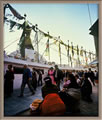 Late afternoon is a wonderful time to visit Bodhnath. As the sun starts to go down, prayer services start, monks and vendors and seemingly the entire community gathers in the alleyways around the great stupa. Then begins the religious ritual of walking around the base of the stupa. But everyone has to walk in a clockwise direction.
Late afternoon is a wonderful time to visit Bodhnath. As the sun starts to go down, prayer services start, monks and vendors and seemingly the entire community gathers in the alleyways around the great stupa. Then begins the religious ritual of walking around the base of the stupa. But everyone has to walk in a clockwise direction. Patan, sometimes referred to as Lalitpur, or 'city of beauty', is just across the river from Kathmandu. Its Durbar Square contains not only the Royal Palace, but also a large number of ancient temples. During one of several visits there, I was surrounded by this colorful and highly tuneful ceremony.
Patan, sometimes referred to as Lalitpur, or 'city of beauty', is just across the river from Kathmandu. Its Durbar Square contains not only the Royal Palace, but also a large number of ancient temples. During one of several visits there, I was surrounded by this colorful and highly tuneful ceremony. This temple was well off the normal tourist trail. Although the scene looks very peaceful, what you can't see are the twenty or so kids crowded around my legs wanting to look through the camera's viewfinder. This was one of only two shots I managed to take before I surrendered my camera and tried to explain how it worked.
This temple was well off the normal tourist trail. Although the scene looks very peaceful, what you can't see are the twenty or so kids crowded around my legs wanting to look through the camera's viewfinder. This was one of only two shots I managed to take before I surrendered my camera and tried to explain how it worked.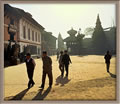 Bhaktapur was the capital of the Kathmandu valley during the 14th to 16th centuries and still retains a thoroughly mediaeval atmosphere. Cars are not permitted within the city, so wandering around the streets is a wonderful experience.
Bhaktapur was the capital of the Kathmandu valley during the 14th to 16th centuries and still retains a thoroughly mediaeval atmosphere. Cars are not permitted within the city, so wandering around the streets is a wonderful experience. The magnificent Golden Gate, or Sun Dhoka, forms the entrance to Bhaktapur's 55 Window Palace. The four-headed multi-armed figure is the goddess Taleju Bhawani.
The magnificent Golden Gate, or Sun Dhoka, forms the entrance to Bhaktapur's 55 Window Palace. The four-headed multi-armed figure is the goddess Taleju Bhawani.
 The very old and the very new. A fascinating temple built into a tree with a massive satellite dish in the background.
The very old and the very new. A fascinating temple built into a tree with a massive satellite dish in the background.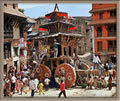 This juggernaut in Taumadhi Tole, Bhaktapur's second great square, was being prepared for a holiday celebration the next day. I watched the activity from the balcony of a very unusual cafe set to one side of the square.
This juggernaut in Taumadhi Tole, Bhaktapur's second great square, was being prepared for a holiday celebration the next day. I watched the activity from the balcony of a very unusual cafe set to one side of the square. Kids playing on a small juggernaut.
Kids playing on a small juggernaut.
 Kids sharing an ice lolly.
Kids sharing an ice lolly. The origins of the temple of Changu Narayan go back to the 4th century. Its somewhat remote location on a hilltop affords it a very serene air. I spent several hours there and did not see one tourist. On the beautiful trail back down to Bhaktapur, about three miles away, I met two brothers who lived locally. In what turned out to be a very special couple of hours, we discussed everything from politics to history, from work to poverty, and even marriage.
The origins of the temple of Changu Narayan go back to the 4th century. Its somewhat remote location on a hilltop affords it a very serene air. I spent several hours there and did not see one tourist. On the beautiful trail back down to Bhaktapur, about three miles away, I met two brothers who lived locally. In what turned out to be a very special couple of hours, we discussed everything from politics to history, from work to poverty, and even marriage.
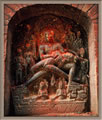
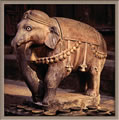
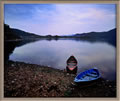 Although Pokhara has undoubtedly embraced tourism, serenity is readily found by following any of the lakeside trails leading out of the town. In this photograph, Pokhara can be seen in the far distance.
Although Pokhara has undoubtedly embraced tourism, serenity is readily found by following any of the lakeside trails leading out of the town. In this photograph, Pokhara can be seen in the far distance.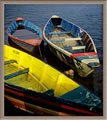 Boats (doongas in Nepali) like these can be rented by the hour to potter around the lake.
Boats (doongas in Nepali) like these can be rented by the hour to potter around the lake.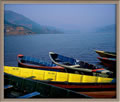
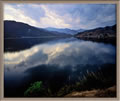 After several hours of contented strolling, I finally noticed that my lakeside walk had taken me a lot further than I had intended. I was depressed by the thought that the only way of returning to Pokhara town was by using my now very tired feet. But on the way back, things got worse: the skies darkened and the heavens opened. And, of course, there was no shelter nearby.
After several hours of contented strolling, I finally noticed that my lakeside walk had taken me a lot further than I had intended. I was depressed by the thought that the only way of returning to Pokhara town was by using my now very tired feet. But on the way back, things got worse: the skies darkened and the heavens opened. And, of course, there was no shelter nearby.
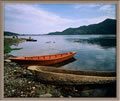 More boats on the lake, but these ones used for fishing by the locals. In the far distance is the town of Pokhara.
More boats on the lake, but these ones used for fishing by the locals. In the far distance is the town of Pokhara.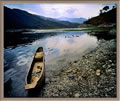


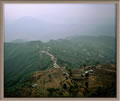 Sarangkot is a short excursion from Pokhara and affords an uninterrupted panorama of the Annapurnas and the lone peak of the 'fish tail' mountain, Machhapuchhare. Mist permitting, of course.
Sarangkot is a short excursion from Pokhara and affords an uninterrupted panorama of the Annapurnas and the lone peak of the 'fish tail' mountain, Machhapuchhare. Mist permitting, of course.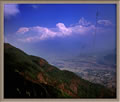 On this occasion, the mist cleared to reveal breathtaking Machhapuchhare.
On this occasion, the mist cleared to reveal breathtaking Machhapuchhare.
Thumbnail panels:
